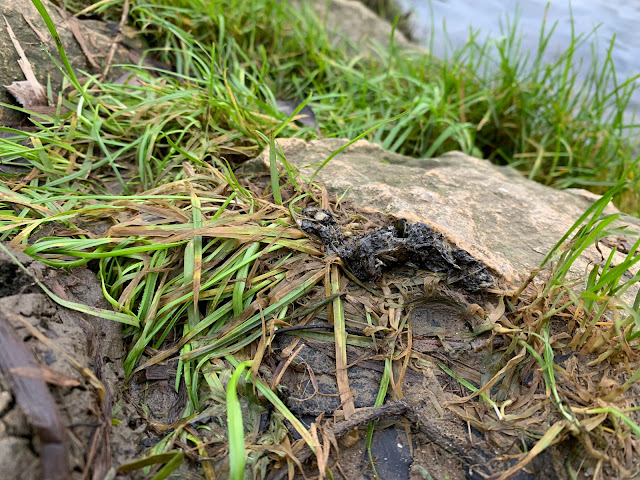When I was a lad otters were nearly extinct in England. Sadly, the first people to realise were otter hunters who found there weren't any left to hunt. The main reason wasn't the hunting but cumulative pesticide toxicity, with other hazards being water pollution and habitat loss. With the banning of Dieldrin etc, legal protection, and improving water quality otter the population has slowly recovered and they are now widespread. Although there were no surveys to recognise their decline, five national surveys have taken place in England in 77-79, 84-86, 91-94, 00-02 and 09-10 to keep an eye on what is happening. Mostly it has been good news. Although there were re-introductions in Yorkshire, East Anglia and Thames, much of the otter population recovery has been natural and they are now found in most of the country apart from the South East. Details of the survey methodology have changed over the years but this chart gives a good idea of the recovery.
This was the situation in the first survey with a few otters in the South West and on the Welsh border and hardly any elsewhere.
This is how England looked in the last survey. Things were promising in the North East and South West but not in the South East.
Separate surveys are undertaken in Wales and Scotland. Worryingly the recent sixth survey in Wales found 22% fewer signs of the animals in nearly all waterways. Although there isn't a direct relationship between field signs and the number of otters, the report concludes that there are fewer otters in Wales. The reasons for the decline are unclear but, being at the top of the food chain, otters are particularly susceptible to accumulation of toxins and chemicals which are now widespread in rivers and waterways, similar in a way to the problems in the 1960s and 70s. The last national survey in Scotland was in 1991-94.
The sixth National Otter Survey of England is now underway. It is being organised by the Mammal Society and is funded by the Environment Agency and Natural England. Half of the country is being surveyed by professionals and the other half by volunteers. England is divided into 100km squares and the north east and south west quarters of each square are being surveyed by volunteers. Each 50km square contains 25 10km squares, and I have been surveying one of them. Take-up of squares has been pretty good across the country apart from those east of Northampton, north of Peterborough and east of London.
All the squares in the North were taken pretty quickly so I took SP65 in Northamptonshire where my mother lives. It mostly involves the villages of Weedon Bec, Flore, Nether Heyford, Bugbrooke and Kislingbury along the upper reaches of the River Nene west of Northampton. As otters are shy and mainly nocturnal and sightings are rare, the survey involves selecting and visiting ten sites within each square to look for signs of otters - spraint (droppings) and footprints.
The best places to look for spraint are under bridges where there is a horizontal structure near the base. Recent heavy rain makes it likely any signs have been washed away but makes it easier to find footprints. Not all the bridges I checked were suitable as on some the pillars went straight down into the water. Others did have a horizontal ledge and there I found spraint, proof of the presence of otters.
I found more spraint at Kislingbury on the rocks below the weir.
In the end four of the ten sites in my square had signs of otters. The survey only requires evidence of otters in one location in a 10km square to be positive but my next step was to set up a trail camera. Last Friday I put a camera under the bridge in the centre of Weedon Bec. A dog otter visited the camera just after midnight and triggered the camera before appearing, making a high quality but brief video. It slipped back into the water with barely a ripple.
On Saturday a second camera was 200m downstream in the tunnel where the river goes under the canal. I knew there would be an otter on the video because when I collected the camera I could see otter tracks going right up to it and then past.
The video starts with a freeze frame so we can get a better look because the otter was very close by the time recording began. It sniffed around and departed in a puff of steam.
Although otters probably don't contribute directly to biodiversity they are key indicators of water quality and of the health of the environment. The otter survey runs until January with results to be published later next year. I am pleased to have made a small contribution to the data collection.











No comments:
Post a Comment